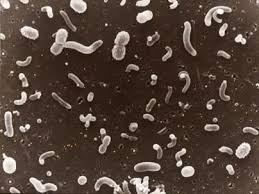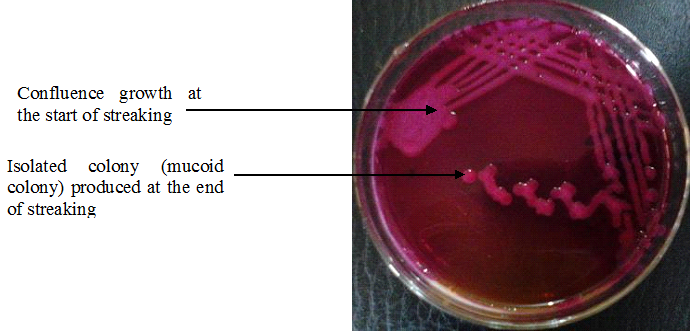Bacillus cereus
Gram-positive rods
Motile organism
Forms endospores
Colonies are non-haemolytic on blood agar
Aerobic & facultative organism
Bacillus anthracis
Gram-positive (or Gram-variable) bacillus
Non-motile organism
Form spores, & are capsulated
Aerobic & facultative anaerobe
Bacillus stearothermophilus
Gram-positive rods
Motile organism
Forms endospores
Aerobic & facultative organism
Has the ability to grow at temperatures of 65oC
Bacillus subtilis
Gram-positive rods
Motile (lateral flagella)
Forms endospores
Aerobic, weak facultative growth
Colonies on agar round or irregular, usually cream-colored
Forms a wrinkled pellicle in broth, little or no turbidity
Branhamella catarrhalis
Gram-negative cocci, often in pairs
Non-motile organism
No endospores
Aerobic organism
Chromobacterium violaceum
Gram-negative rods with rounded ends
Motile organism
No endospores
Facultative organism
Forms round violet colonies on agar
Produces a violet ring at the surface of liquid media
Clostridium histolyticum, C. acetobutylicum, C. sporogenes
Rods, may occur in pairs or short chains
Mostly Gram-positive organism
Motile organism
Forms endospores
Obligate anaerobe
Will not grow on agar plates unless incubated anaerobically
Corynebacterium pseudodiphtheriticum
Gram-positive rods, frequently show club-shaped swellings and palisade arrangement
Non-motile organism
No endospores
Aerobic and facultative
White to cream-color colonies on agar
Surface pellicle in broth
Corynebacterium xerosis
Gram-positive rods
Non-motile organism
No endospores
Aerobic and facultative
Enterobacter aerogenes
Gram-negative rods
Motile organism
No endospores
Facultative organism
Enteric organism
Escherichia coli
Gram-negative straight rods which tend to become quite short
Motile
No endospores
Facultative organism
Colonies on agar white to grayish in color
In broth produces a general turbidity and a heavy deposit
Enteric organism
Flavobacterium capsulatum
Gram-negative capsulated short rods, often in chains
Non-motile organism
No endospores
Facultative psychrophile
Yellowish colonies on agar
Klebsiella pneumoniae
Gram-negative capsulated rods often in pairs or short chains
Non-motile organism
No endospores
Facultative organism
Colonies on agar dome-shaped, mucoid and glistening or shiny
Enteric organism
Kurthia zopfii
Gram positive rod
Motile organism
No endospores
Aerobic organism
Micrococcus roseus
Gram-positive cocci
Some strains are motile, some are not
No endospores
Aerobic or facultative
Pinkish colonies on agar
Slight turbidity in broth, fine deposit
Mycobacterium tuberculosis
Gram-positive straight or slightly curved slender rod
Non-motile (Acid-fast organism)
No endospores
Non-sporing
Aerobic organism
Cultures produce slow-growing colonies that are usually raised, dry 7 cream coloured
Mycobacterium smegmatis
Slender rods that accept Gram stain poorly, considered Gram positive
Non-motile (Acid-fast organism)
No endospores
Aerobic organism
Slow growth with creamy white or yellowish colonies with a waxy texture
Creamy pellicle and sediment in broth
Neisseria sicca
Gram negative cocci, often in pairs
Non-motile
No endospores
Aerobic or facultative
Colonies on agar yellowish, dry grayish or slimy white
Propionibacterium acnes
Pleomorphic rods–often coccoid, club-shaped
Gram positive organism
Anaerobic to aero-tolerant
Non-motile organism
No endospores
Grow poorly if at all on the surface of agar
Broth turbid or clear with granular sediment
Proteus vulgaris
Gram-negative rods
Motile organism
No endospores
Facultative organism
Colonies may produce swarming growth
Enteric organism
Pseudomonas cepacia
Gram-negative rods
Motile organism
No endospores
Aerobic organism
Cultures may produce a greenish-old fluorescent pigment
Pseudomonas aeruginosa
Gram-negative rods
Motile
Non-sporing
Obligatory aerobe
Cultures produce pigments on agar including pyocyanin (a blue-green pigment) & pyoverdin (fluorescein)
Aquaspirillum serpens
Gram-negative spirals
Motile organism
No endospores
Aerobic organism
Pseudomonas fluorescens & P. putida
Gram-negative straight or slightly curved rods
Motile organism
No endospores
Aerobic organism
Cultures may produce a greenish-gold fluorescent pigment (for P. fluorescens)
They grow at 4oC, and are opportunistic Pseudomonads of low pathogenicity.
Burkholderia pseudomallei
Gram negative rod
Non-motile organism
Produces non-haemolytic, small, dry and ringed colonies on agar
Non-sporing organism
Aerobic organism
Campylobacter jejuni & C. coli
Gram negative spirally curved bacteria
Motile organism
Non-spore forming organism
Colonies on blood agar are non-haemolytic
Strictly micro-aerophilic
Helicobacter pylori
Gram-negative curved spirals
Motile organism
Non-spore forming
Micro-aerophilic organism
Colonies are slightly beta-haemolytic on blood agar, and they grow slowly forming grey translucent colonies on agar
Yersinia pestis Y. enterocolitica
Gram-negative coccobacillus
Non-motile (Y. enterocolitica is motile at 20-28oC & non-motile at 35-37oC)
Non-sporing organism
Colonies on blood agar are small, shiny and non-haemolytic. On MacConkey agar, small translucent pink colonies are formed
Aerobe and facultative anaerobe
Haemophilus influenzae & H. ducreyi
Gram-negative coccobacillus or short rod
Non-motile organism
Non-sporing organism
Colonies on agar are mucoid with a distinct smell
Facultative or aerobic organism
Bordetella pertussis
Gram-negative (capsulated) coccobacillus
Non-motile organism
Strict aerobes
Colonies produce small pearly-grey shiny mucoid colonies
Streptococcus pyogenes
Gram-positive cocci, commonly in short chains, pairs or singly
Non-motile organism
No endospores
Colonies on blood agar are beta-haemolytic
Micro-aerophilic organism
Enterococcus faecalis
Gram-positive cocci, commonly occurring in short chains or pairs
Non-motile organism
Non-spore forming organism
Colonies are usually non-haemolytic, but some show alpha- or beta-haemolysis. They also produce small dark-red and small yellow colonies on MacConkey agar and CLED respectively
Aerobic organism
Listeria monocytogenes
Gram-positive small rod or coccobacillus
Weakly motile or non-motile
Non-sporing & non-capsulated
Colonies on agar are small, grey, & translucent drop-like, & are surrounded by small level of beta-haemolysis
Aerobe & facultative anaerobe
Clostridium perfringens
Gram-positive thick rod
Spore forming organism
Non-motile organism
Colonies on blood agar are beta-haemolytic
Facultative anaerobe
Clostridium botulinum & C. tetani
Gram-positive Pleomorphic rod
Motile organism (some strains of C. tetani are non-motile)
Spore forming organism
Colonies are usually beta-haemolytic
Strict anaerobe
Neisseria meningitidis & N. gonorrhoeae
Gram-negative diplococcus
Non-motile organism
No endospores
Colonies are transparent or grey & shiny
Aerobe (N. gonorrhoeae is aerobic & facultative anaerobe)
Rhodococcus rhodocrous
Gram-positive rods
Non-motile organism
No endospores
Aerobic organism
Rhodospirillum rubrum
Gram-negative spirals
Motile organism
No endospores
Facultative organism
Pinkish colonies on agar
Pinkish color to liquid media
Sarcina aurantica
Gram-positive coccus
Non-motile organism
No endospores
Aero-tolerant organism
Sarcina lutea
Gram-positive coccus, often occurs in packets of 8 cells under the microscope
Non-motile organism
No endospores
Anaerobic but will grow in the presence of oxygen (aero-tolerant)
Colonies on agar generally produce a bright yellow pigment
Serratia marcescens
Gram-negative rods
Motile organism
No endospores
Facultative organism
Colonies on agar may produce pink pigment
Broth cultures may have a pink color
Enteric organism
Spirillum serpens
Gram-negative spirals
Motile organism
No endospores
Sporosarcina ureae
Gram-positive cocci, may form tetrads
Motile organism
Forms endospores
Aerobic organism
Colonies on agar may have a granular appearance
Staphylococcus epidermidis
Gram-positive cocci which form irregular clusters
Non-motile organism
No endospores
Facultative organism
Colonies on agar are smooth and may be pale yellow or white
Streptococcus lactis
Gram-positive cocci, commonly form chains
Non-motile organism
No endospores
Micro-aerophilic organism
On agar forms tiny almost colorless colonies
No pellicle in broth
Streptococcus salivarius
Gram-positive coccus
Non-motile organism
No endospores
Micro-aerophilic organism
Vibrio cholerae
Gram-negative straight or curved rod
Motile organism
Non-sporing
Aerobe and facultative anaerobe
Colonies are yellow on thiosulphat-citrate bile salt sucrose (TCBS) agar
Vibrio angular
Gram-negative curved rod
Motile organism
No endospores
Vibrio fischeri
Gram-negative curved rod
Motile organism
No endospores
Bioluminescent organism
Shigella species
Gram-negative rods
Non-motile organism
Non-sporing organism
Non-capsulated organism
Aerobes & facultative anaerobe
Colonies are red-pink on agar
Enteric organism
Salmonella species
Gram-negative rods
Motile organism
Non-sporing organism
Non-capsulated (except S. typhi)
Aerobes & facultative anaerobe
Colonies are pink-red on agar
Discover more from #1 Microbiology Resource Hub
Subscribe to get the latest posts to your email.



